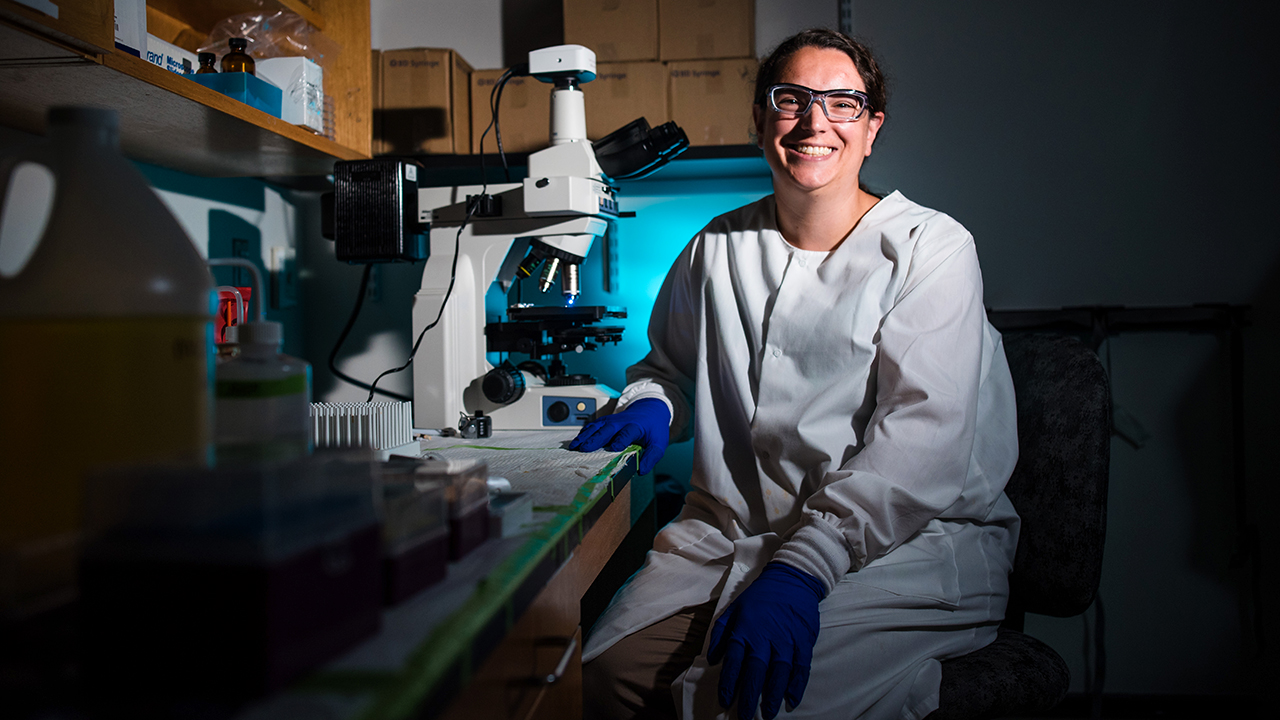- YouTube
- TikTok
OU’s Dr. Sara Blumer-Schuette earns recognition in renowned AEM journal
Research could lead to a better understanding of how pathogens ‘set up shop’ inside the human body

Dr. Sara Blumer-Schuette, an assistant professor of biological sciences at Oakland University whose research could lead to a better understanding of how pathogens “set up shop” inside the human body, has been selected for an editorial spotlight in an upcoming issue of Applied and Environmental Microbiology (AEM), a biweekly, peer-reviewed scientific journal published by the American Society for Microbiology.
“AEM is one of the more renowned journals in my field,” Blumer-Schuette said. “To be able to get a paper accepted by AEM, especially about one of the main projects out of my lab, is really exciting.”
The paper highlights Dr. Blumer-Schuette’s work with Caldicellulosiruptor bescii, a type of bacteria commonly used to generate next generation biofuels, which are also known as microbiofuels.
“These organisms grow primarily in hot springs, and we were interested in them because they can essentially transform plant biomass (tissue) into biofuels at very high temperatures, which makes it very attractive to companies because you don’t have to worry about other organisms living at those temperatures and it makes it a little easier to extract biofuels,” Blumer-Schuette said.
While working with Caldicellulosiruptor bescii, Blumer-Schuette was able to identify a protein in the bacteria that helped the organism stick to the cellulose, a type of sugar, found in plant tissue.
“It’s a rather unusual protein, but because we had already sequenced the genomes of these organisms, I knew exactly where the gene was that was in charge of making this protein,” Blumer-Schuette said. “When I looked in the neighborhood of that gene, I also saw other genes that encode for proteins that pathogens — organisms that cause disease — use to stick to surfaces. We call them pilins.”
Based on her research, Blumer-Schuette found that the pilin proteins assemble to form filaments that extend out from the Caldicellulosiruptor bescii bacteria to help them stick to the cellulose, similar to the way a fisherman casts a line to catch a fish.
“What we’re demonstrating in this paper is that not only are the sticky cellulose binding proteins involved in helping these bacteria attach to plant tissue, they’re also using these pilin ‘fishing rods’ to attach to two different types of sugars that you commonly find in plant tissues,” she said.
“Where it gets a little exciting is while other scientists have seen or described the use of these pilin proteins in pathogens that attach to metal surfaces or to human cells, no one had really looked at bacteria that grow at these really high temperatures to see if they were using a similar system.”
According to Blumer-Schuette, the bacteria she’s been working also shares “a common evolutionary history” with the pathogens the cause diseases such as Clostridium difficile (C. diff), Botulism, and Gangrene.
“They’re essentially the many times removed great grandparents of some pretty nasty diseases,” she said. “My organisms aren’t pathogens, but when I look at the gene neighborhood in my organism and I compare it to the gene neighborhood in these pathogens, I begin to see some similarities.
“My hypothesis is that because the systems look similar, at least on a gene basis, that what I’m seeing in the Caldicellulosiruptor bescii bacteria could guide us into some of the mechanisms that these clostridial pathogens are using,” Blumer-Schuette added. “The bottom line is, if we can understand how bacteria are attaching to surfaces, we can also start to pursue ways to stop that process. And when we think about pathogens, stopping a pathogen from ‘setting up shop’ in your body could help us fight that disease.”
To learn more about Dr. Blumer-Schuette’s work, visit aem.asm.org.


 March 23, 2020
March 23, 2020